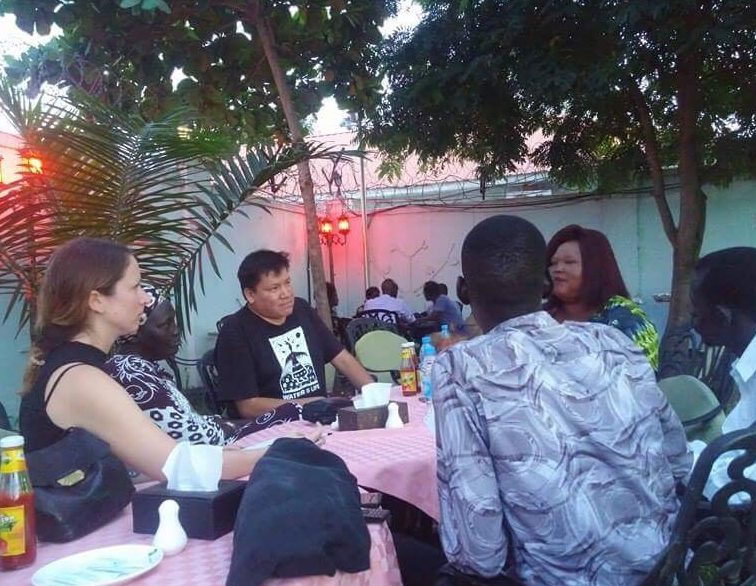By Lenny Carpenter
Indigenous Reporters Program manager
It all started one summer morning when I joined fellow program manager Zein Almoghraby for a cigarette outside the JHR head office. We made some chatter about a recent meeting when he suddenly changed the subject.
“Do you want to go to South Sudan?” he asked. I wondered whether he was joking, but I gave him my immediate response: “Yeah, I’ll go to South Sudan.”
Why would anyone want to go to South Sudan? The country topped the Fragile States Index — an annual list and report that assesses states’ vulnerability to conflict or collapse — for the past two years. Last summer, shortly after I started working at JHR, our team in South Sudan was evacuated after fighting broke out in the capital city.

View of compounds in Juba
And as the Indigenous Reporters Program (IRP) manager, I oversee JHR’s only Canada-based program, rarely working directly on the five projects we are currently operating overseas.
But Zein, who has a background of law and human rights activism, sought my experience as a reporter, editor and publisher for Wawatay News, a First Nations newspaper in northern Ontario, an area of expertise I could bring to South Sudan. It would be a cross-program exchange, of sorts. And, truth be told, I had never travelled across any ocean and saw this as an opportunity to do so. Even if it is to a country mired in civil war.
Three months later after that morning cigarette, we flew into the Juba International Airport on Oct. 21. It’s not what you’d expect of an international airport. Instead of the massive terminals, or even the basic structures I’ve seen in the fly-in First Nations in northern Ontario, we entered a tent with crumbled wooden flooring to go through customs.
Zein had a momentary problem with his paperwork, and he told me to go ahead to find the JHR team waiting outside. So I found myself alone in my first moments in an African country. I was approached by a number of young South Sudanese men. I couldn’t understand what they were saying until I made out the word “baggage” so I handed my baggage tag. It wasn’t until he handed my bag to me outside and asked for a monetary award that I realized he wasn’t an airport worker.
Now, the biggest concern I had about coming to South Sudan wasn’t necessarily the potential danger and violence, but the heat. I grew up on the James Bay coast where winter temperatures often dip to -40 C. Zein and I often battle over the thermostat in the JHR head office. But in the first few days, I actually found the plus-30 C heat to be manageable. It probably would be less tolerable if my hotel room did not have air conditioning.
The core of the city is strewn with compounds: 10-foot tall walls topped with barbed wires with gates guarded by soldiers or private security personnel. At night, soldiers with AK-47’s or other variants stop vehicles at check points for inspection of passengers and contents.
A driver shuttles us from location to location. Zein made it clear to me before the trip that it’s unsafe to walk through the streets. Taking photos out in public are strictly prohibited.
The security situation does not allow a lot of interacting with everyday locals. Often we are driven from compound to compound — offices, training centres, embassies, apartment complexes, and hotels, including ours.

IRP manager Lenny Carpenter (third from left) and JHR’s South Sudan team leader Laura Zain (far left) listen in during a workshop with Juba-based media managers.
But those we have met with are an example of the courage and hope in a country that declared famine, and which faces an ongoing civil war that had left two million people displaced and forced one million to flee to nearby countries.
During meetings or workshops with civil society organizations or local media managers on this trip: we’ve watched a radio program where a young, new host questioned a fuel company exec on the country’s fuel crisis. We’ve attended a planning meeting for a conference to end impunity on crimes against journalists. I spoke with a young woman who co-founded and co-funded a weekly print newspaper aimed at youth to inform them of their rights, and providing space for their contributions. As she told me, despite the danger her mother warned of being a journalist in South Sudan, she wants to “give a voice to the voiceless.”
I can’t help but think of Indigenous communities back home: in that the people are widely seen to be plagued with problems and issues, but often ignored are those working hard to find solutions and improve conditions for their people.
It certainly has been a real cross-program exchange, with learning going both ways.


